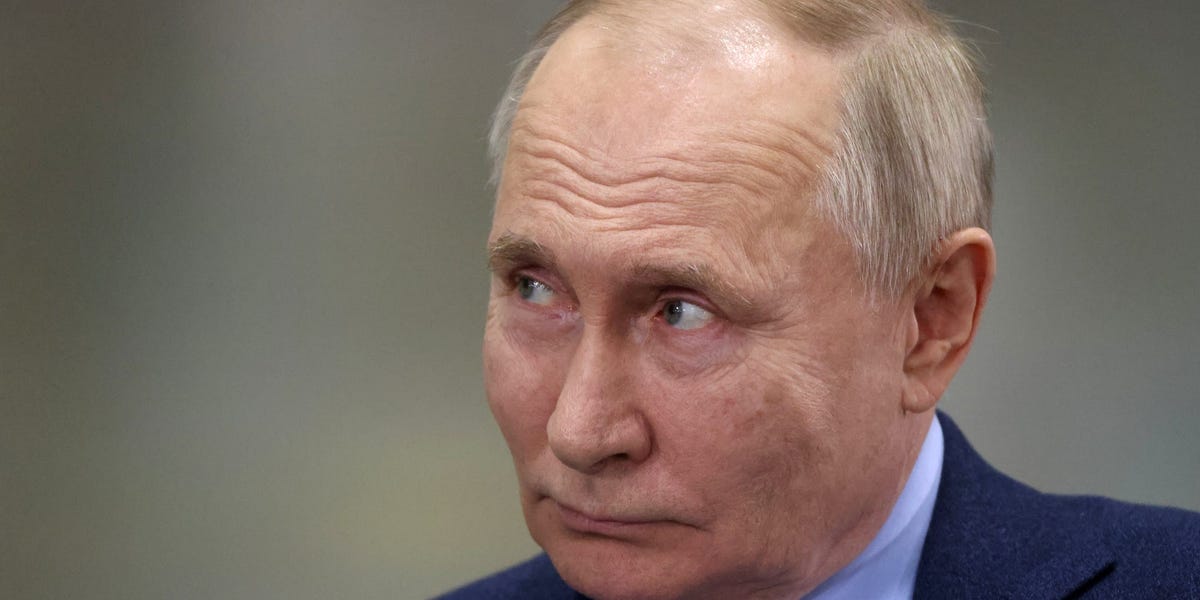- Western sanctions against Russia haven’t significantly hindered its wartime economy.
- Analysts say the “porous” nature of sanctions has allowed Russia to sidestep restrictions.
- Sources say additional sanctions could pick better targets to put the squeeze on Russia.
Thanks for signing up!
Access your favorite topics in a personalized feed while you’re on the go.
download the app

Western nations’ attempts at ending Russia’s invasion of Ukraine via economic sanctions are hitting a snag, and the measures seem not as large a hit to Vladimir Putin as expected.
Sanctions and trade restrictions have slammed Russia’s economy since it invaded Ukraine two years ago, targeting key areas like energy, freezing foreign assets, and cutting the nation’s financial ties to much of the West.
But the reality is that Russia’s wartime economy has done OK despite all that. Following a 1.2% GDP dip in 2022, Moscow boasted a 3.6% annual growth in 2023, hitting an all-time low unemployment rate of 2.9%.
Russia expert Owen Matthews, author of “Overreach: The Inside Story of Putin and Russia’s War Against Ukraine,” told Business Insider on Friday that the explosion of the Nord Stream pipelines in September 2022 seems to be a bigger blow to Russia’s economy than the West’s sanctions so far.
Analysts said the sanctions toolkit has been “porous,” giving Moscow many ways to slip through the web of restrictions, but there’s a lot more Western countries can do to ramp up the pressure.
Liam Peach, a senior emerging markets economist of Capital Economics, highlighted Russia’s adeptness at sidestepping trade restrictions in a note last week.
“The US has tightened sanctions evasion on firms that help Russia import through third countries, but trade has a way of finding new routes and it’s hard to police. If it is profitable to evade sanctions, some firms will take the risk,” he wrote.
According to Peach, sanctions haven’t halted money from non-Western countries flowing to Russia. Even G7’s bid to curb export income through a $60 per barrel cap on the price of oil hasn’t really hobbled Moscow’s oil trade.
FX Share of Russian Export Settlement (%)
Source: Central Bank of Russia, Capital Economics
“The US has noted a large increase in banking flows between Russia and Turkey and the UAE. The West has reduced imports of Russian energy significantly but Russia has largely re-routed oil exports to Asia.”
Meanwhile, Matthews notes that European nations rarely say no to certain energy supplies from Russia, sabotaging their own attempts at punishing Putin.
“The whole kind of dirty secret behind all the European sanctions packages was that, for instance, Europe talked a big game about sanctions against Russia, but they never sanctioned Russian gas,” he said.
Even with regard to US-dominated financial sanctions, limited headway has been made, according to Matthews.
The dominance of the US dollar as a trade and reserve currency forced Russia to de-dollarize, and Russia can still bypass the US-controlled global finance system with the help of China.
Russia-China Goods Trade (SA, $bn)
Source: Refinitiv, Capital Economics
“Inadvertently, that sort of sanctions regime has just encouraged more Renminbi denominated transactions and has massively boosted Dubai specifically as the major sort of non-American dominated hub for financial transactions,” Matthews said.
What else can the West do?
Peach wrote that the West could squeeze Russian energy more by slapping secondary sanctions on third-party purchases of oil and gas from the country.
“Russia doesn’t need to borrow from abroad, but it does need foreign currency in the form of energy exports to finance the budget, pay for imports, and stabilize the ruble.”
But it’s unlikely for the West to take this path, he added, given Russia’s energy dominance and the risk of sparking volatility that could end up antagonizing partners like India.
Alternatively, the US could target Russia’s non-oil exports, particularly industrial metals and liquefied natural gas, Peach added.
With current sanctions falling short, Peach estimates GDP growth for the country to clock in at 3.0%-3.5% this year and year-end inflation at 5.5%-6.0%. However, he reaffirmed that sanctions are set to persist.
“Sanctions are unlikely to be rolled back over the next six years, especially if Russia mobilizes further and pursues a more aggressive war,” Peach said, adding that even with a negotiated settlement, unfreezing Russia’s foreign exchange reserves is probably “out of the question.”


